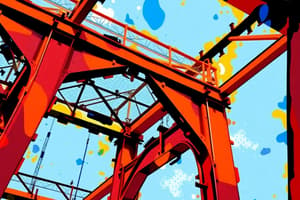Podcast
Questions and Answers
What is the main purpose of structural steel design?
What is the main purpose of structural steel design?
To check the viability of steel for any kind of project.
Steel structures can warp, buckle, twist, or bend.
Steel structures can warp, buckle, twist, or bend.
False (B)
Which of the following is a type of steel section used for construction?
Which of the following is a type of steel section used for construction?
- Parallel Flange Channels
- Tapered Flange Beam
- Universal Beam & Column
- All of the above (correct)
Angled sections are commonly used in residential construction, infrastructure, mining, and ___.
Angled sections are commonly used in residential construction, infrastructure, mining, and ___.
What shape do Universal Beams and Columns resemble when standing upright?
What shape do Universal Beams and Columns resemble when standing upright?
What is a characteristic of Circular Hollow Sections compared to Tapered Flange Beams?
What is a characteristic of Circular Hollow Sections compared to Tapered Flange Beams?
Which type of structural steel is often referred to as 'box sections'?
Which type of structural steel is often referred to as 'box sections'?
Flat sections are used as strengthening tools attached to other sections.
Flat sections are used as strengthening tools attached to other sections.
What is a common use for Square Bars?
What is a common use for Square Bars?
What are the two types of rolled steel?
What are the two types of rolled steel?
Flashcards are hidden until you start studying
Study Notes
Steel Design
- Steel design is a branch of structural engineering that focuses on designing structures using steel.
- Steel designs are essential for checking the suitability of steel in various construction projects.
Importance of Steel in Construction
- Steel offers superior strength compared to wood frames and brick walls.
- It resists warping, buckling, twisting, and bending.
- Steel is flexible and easy to install.
- Its high quality and ease of maintenance make it a desirable building material.
Steel Section Types
- Parallel Flange Channels (PFC): U-shaped with right angles, similar to a staple, they come in various sizes with parallel sides. High strength-to-weight ratio, similar uses to angled sections.
- Tapered Flange Beam: I-shaped, available in various sizes, frequently used as girders. Not recommended for pressure along the length due to poor torsion resistance.
- Universal Beam & Column (American Standard Beam or Wide-Flange Shapes): I-shaped upright and H-shaped on its side. Made of structural steel, used in construction due to excellent load-bearing capabilities.
- Angled Sections: Right-angled, unequal sections have different sized axis, creating an L-shape. Used in residential construction, infrastructure, mining, and transport, available in various lengths and sizes.
- Circular Hollow Sections: Tubular cross sections, higher resistance to torsion than tapered flange beams. Uniform wall density makes them suitable for multi-axis loading applications.
- Rectangular Hollow Sections: Similar to circular hollow sections, widely used in mechanical and construction applications. Flat surfaces facilitate joining and metal fabrication. Used in smaller applications as columns/posts, unsuitable for beams due to shape constraints. Also known as "box sections".
- Flat Sections: Versatile, require attachment to other sections. Used as strengthening tools, often called "plates" (like checker plates).
- T-Sections: Consist of a flange and web arranged in a "T" shape. Used in steel roof trusses to create compound sections. Two angle sections can be joined to create a T-section.
- Deformed and Round Bars: Circular cross-sections, used for reinforcement in concrete and steel grill work. Available in various diameters (10mm, 12mm, 16mm, 20mm, 25mm, 28mm, 32mm, 36mm, 40mm, 45mm, 50mm).
- Square Bars: Square cross-sections, widely used for gates, window grills, etc. Sides range from 5mm to 250mm.
Rolling Process in Metalworking
- Metal stock passes through one or more pairs of rolls to reduce thickness, achieve uniform thickness, or impart mechanical properties. Similar to rolling dough.
Types of Rolled Steel
- Hot Rolled Steel: Extreme heat treatment during production, begins with billets (large, rectangular metals) that are heated and flattened into large rolls.
- Cold Rolled Steel: Involves heating and cooling processes, resulting in improved surface finish, dimensional accuracy, and strength compared to hot rolled steel.
Studying That Suits You
Use AI to generate personalized quizzes and flashcards to suit your learning preferences.




